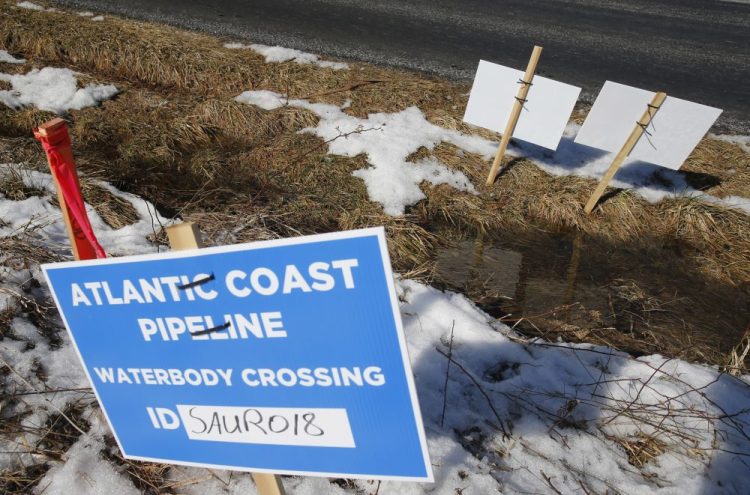The Supreme Court on Monday appeared ready to remove an obstacle to construction of the Atlantic Coast Pipeline, with a majority of justices expressing skepticism about a lower court ruling that tossed out a key permit needed for the natural gas pipeline to cross under the Appalachian Trial.
Justices on the court grilled a lawyer for environmental groups who sued and won a 2018 ruling from the Richmond-based 4th U.S. Circuit Court of Appeal throwing out a special-use permit for the 605-mile natural gas pipeline.
The 4th Circuit found the U.S. Forest Service did not have the authority to grant a right-of-way to allow the pipeline to cross beneath the Appalachian Trail in a Virginia section of the George Washington National Forest.
But conservative justices, who hold a 5-4 majority on the Supreme Court, expressed reservations about the ruling, with Chief Justice John Roberts at one point saying the lower court’s finding would “erect an impermeable barrier” to any pipeline from areas where natural gas is located to areas where it is needed.
“Absolutely incorrect,” attorney Michael Kellogg, representing the environmental groups, responded.
Kellogg said there are currently 35 pipelines that run under the Appalachian Trail, 19 of them on federal land with easements granted before the Appalachian Trail was designated as a national scenic trail under the 1968 National Trails System Act. The remaining pipelines are on state and private land, he said.
But Justice Brett Kavanaugh told Kellogg that the environmental groups’ position has “significant consequences to it, enormous consequences.”
The 4th Circuit found that the 1920 Mineral Leasing Act allows rights-of-way for pipelines on federal land, except for land in the National Park System. The court found that the trail is considered a unit of the National Park System, so the Forest Service doesn’t have the authority to approve a right-of-way.
Lawyers for project developers — Dominion Energy and Duke Energy — backed by the Trump administration, say the Forest Service has jurisdiction over land in the George Washington National Forest, where a 0.1-mile segment of the pipeline would cross about 600 feet beneath the Appalachian Trail. The pipeline would bring natural gas from West Virginia to North Carolina and Virginia.
The Sierra Club and other environmental groups say that because the 2,200-mile scenic trail is considered a unit of the National Park System, no federal agency can grant a right-of-way for the pipeline. They say only Congress can approve such a crossing.
The narrow question before the Supreme Court is whether the Forest Service has the authority to grant rights-of-way through lands crossed by the Appalachian Trail within national forests.
Conservative justices expressed concern that concluding that no federal agency can grant easements for pipeline projects on lands crossed by the trail within national forests could erect a roadblock to energy infrastructure projects.
Dominion and the federal government say the 1968 National Trails System Act, which designated the Appalachian Trail as a national scenic trial, did not transfer lands crossed by the trail to the National Park Service. They argue that although the Park Service is charged with overall administration of the trail, the actual lands crossed by the trail within national forests remain under the jurisdiction of the Forest Service.
The court’s liberal justices appeared skeptical of the argument made by Dominion and the government that the trail cannot be considered “land” in the National Park System because it is only a right-of-way that crosses federal land under the jurisdiction of the Forest Service.
“It’s a … difficult distinction to wrap one’s head around,” Justice Elena Kagan said.
“When you walk on the trail, when you bike on the trail, when you backpack on the trail, you’re backpacking and biking and walking on land aren’t you?” Kagan asked Assistant Solicitor General Anthony Yang.
But the conservative justices and Justice Stephen Breyer, considered to be a member of the court’s liberal wing, repeatedly noted that the pipeline will be buried more than 600 feet below the Appalachian Trail so would not actually go across the trail.
Even if the court rules in favor of the project developers, the Forest Service would still need to address three other issues cited by the 4th Circuit when it tossed out the permit, including the court’s finding that the agency had failed to fully consider alternative routes to avoid national forests.
The project has had numerous setbacks since plans were first announced in 2014. Legal challenges brought by environmental groups have prompted the dismissal or suspension of eight permits and halted construction for more than a year.
The project is now three years behind schedule and its original price tag has nearly doubled to $8 billion.
Dominion says the pipeline will bring a critical new gas supply to Virginia and North Carolina to support the shift away from coal and toward intermittent natural resources like solar. The company also says greater availability of natural gas will attract manufacturing businesses.
Environmental groups say the pipeline would scar pristine landscapes, put numerous rivers and streams at risk of increased sedimentation and harm sensitive species.
Comments are not available on this story.
Send questions/comments to the editors.


